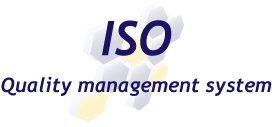See how the software can help you implementing the 8 principles of the ISO 9001:
Principle 1: the company must listen to its customers in order to understand their present and future needs, meet their requirements and exceed their expectations.
Answer: the GME method puts the customer at the heart of its concerns and even aims at exceeding the customer’s requirements. It’s objective is to move towards delivery to each customer at the lowest cost, without zero defect and immediately, thanks to the reduction of all the losses during the total chain of development, production and distribution.
Principle 2: management must clearly define the ultimate aims, orientations and practices of the company and create a mobilizing context for the whole personnel.
Answer: management is supported and advised in its actions. The first stage consists of defining the Management vision. This vision is presented to the whole workforce and becomes mobilizes everyone in a shared cause. Clear and measurable objectives are derived from this vision. They will be passed on and converted into operational objectives, intended for each unit of the organisation.
Principle 3: all the players in the company must feel involved in the achievement of the objectives defined by Management
Answer: GME ensures that all the players are involved in the company’s project because acceptance and participation are essential elements within progress. Each person is made aware and involved: the success of the individual objectives contributes to the overall success.
Principle 4: the company must be defined as a serie of correlated processes.
Answer: GME guides businesses towards an internal organisation of inter-connected processes. The software implemented, Factory 5.0, is specially designed for this purpose. The communication principle adopted is extremely simple: each service, department, process,… must place at the disposal of the company and his/her “colleagues” all the elements essential to their operation. The pages relating to the Software give you all information necessary.
Principle 5: all the business processes must be identified, defined and optimized with an objective of effectiveness and efficiency.
Answer: GME clearly identifies the various processes in a role customer supplier (intern or external). The organization takes care that each process is provided with all the elements, necessary and sufficient, which enables it to be carried out under the best conditions of quality and effectiveness. Thus, for example, an industrial workstation knows – via a computer screen – all the items useful to its operation such as: technical specifications, raw-material specifications, procedures, safety instructions, quantitative and qualitative targets, performance history, tools for recording abnormal situations and stoppages,… Thanks to the daily reports, generated automatically, the objectives are known, measured and displayed. Whether targets are being met or not is discussed on a daily basis.
Principle 6: the company must begin a continuous improvement procedure.
Answer: GME is a method which is based primarily on continuous improvement while relying the participation of the workforce. It evaluates the situation of the company at the point of launching and ensures precise and measured monitoring. The indicators already used by the company are communicated better, because they use new media. Performance Indicators, specific to the GME method are also established.
Principle 7: the company must establish mutually beneficial relationships with its suppliers.
Answer: relationships with suppliers will be all the more beneficial if they rely on objective information. Thanks to the recording and measuring tools used by the GME method, monitoring of suppliers will be precise and rational. Non-conformities will be evaluated much more effectively, in a relationship of greater trust, for the benefit of both parties.
Principle 8: all decisions must rely on objective data and information.
Answer: GME is based on communication, recording, decision and analysis software: Factory. Events observed by the personnel: technical abnormalities, problems with organization, quality, adjustment, changes in the process,… are recorded by means of simple and perfectly adapted tools. The performances of the processes or the equipment are also recorded, automatically or manually. Corrective actions are taken on the basis of these criteria: recorded abnormalities and whether or not targets have been met. Traceability of actions is also always guaranteed, as are completion dates. Decisions are monitored in real time. Moreover, thanks to the potential of data processing, data bases accumulate a wealth of input with the passing days and it becomes possible to extract very useful information about problems encountered the reliability of certain equipment, and the effectiveness of particular processes. The graphic analysis makes it possible to locate the defects and to concentrate the corrective actions on the most critical problems.
 EN
EN Fr
Fr
